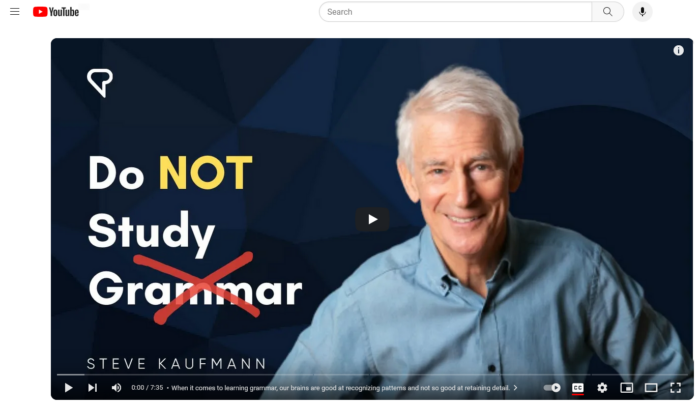How Important is Grammar When Learning a Language?
Read other articles:
Back to posts
Table of Contents

Why does Steve Kaufmann, the Canadian polyglot who can speak 20 languages, say “Do NOT study grammar”?
Doesn’t this fly in the face of what language learners have been told?
Most traditional methods for language learning stress the importance of studying grammar when learning a language. But does this mean that learners who are looking to attain a high level of proficiency with their chosen language need to spend most of their time with their heads buried in books learning grammar rules?
Fortunately, not. As Kaufmann points out, some of the most successful approaches to language acquisition marginalize the importance of studying grammar and stress the value of exposure to it. Others recognize the importance of grammar at certain stages of language acquisition but do not consider it central to the process.
Let’s take a closer look at how important grammar is to learning a language effectively — and why you can potentially learn a language without ever even studying grammar.
- What is grammar?
- The traditional view on language learning
- Limitations of learning a language by studying grammar
- The real importance of grammar when learning a language
- How can you use grammar effectively in language learning?
- Download our free app to boost language exposure
What is grammar?

We sometimes refer to grammar as the “rules” of a language but that’s not strictly true. Nobody sat down and created a set of rules for a language to follow — except those who invented Esperanto.
Languages evolve naturally and continue to do so. Grammar, then, more correctly refers to the structure and system of a language.
Observations about syntax (the arrangement or order of words) and morphology (the internal structure of words), which are the basics of what we call “grammar”, have been compiled by academics who document the language rather than forming an integral part of it. Indeed, fluent native speakers may never even know the grammar of their mother tongue.
The traditional view on language learning
The traditional view is that grammar is critical for learning any language and is the foundation for speaking and understanding that language. It explains how sentences are formed and the way words work together as a system, underpinning everything important to know.
That’s why the grammar-translation method remains the most-used method for language learning around the world. Even many of the latest language learning apps still base learning on making grammar more fun.
However, people around the world speak their native languages fluently without ever having studied grammar.
Children absorb language naturally before they ever sit in a classroom and begin studying its structure. In other words, most children aged three to five are already experienced language pros before they even become aware of the word “grammar”.
If it’s possible to learn a language without studying grammar, why do so many people insist on the study of grammar as fundamental to the process? Especially when it may be slowing their language journey down rather than accelerating it.
Traditionally, perhaps, grammar has been the easiest way to teach languages in a classroom setting, with teachers, textbooks, and whiteboards. It’s easy for education departments to get the necessary resources and measure progress. People have become accustomed to starting here with languages.
As more and more language learners find different non-classroom settings in which to learn languages, the emphasis on grammar may be reduced. However, convincing students that they can learn a language without studying grammar can be challenging because of deeply ingrained beliefs about language learning that go back to school days.
When learners realize that they don’t need to spend hours with their heads in grammar textbooks, there’s often an audible sigh of relief!

Limitations of learning a language by studying grammar
Studying grammar is rarely an effective way to acquire a language because of the following reasons:
- Instruction is often in the learner’s native tongue rather than the target language (this is often the case even when video or app technology is used to learn).
- Learning is often “quick but shallow” meaning that learning points are often quickly forgotten.
- Over-reliance on tests and output rather than listening, reading, watching, and other language input.
- Little natural context is usually provided, so learning points are not memorable and may not “stick” very well.
- Lack of engagement with the topic: only the most motivated language learners find grammar compelling (mostly, it’s met with groans!)
- Exceptions to grammar “rules”: many times, languages break the logical set of observations that have been outlined for the language.
Nobody learns how to play a musical instrument purely by studying music theory. It’s similar to effective language learning…
The real importance of grammar when learning a language
Nobody’s saying that grammar is irrelevant. Incorrect grammar might lead to a sentence such as this:
How a Learning When Grammar Important is Language?
All the words are jumbled and it doesn’t make sense. Grammar imparts clear meaning to sentences — but do we need to study that when we first set out to learn a language?
Or are there other, more effective places to focus one’s attention?

Like Kaufmann, Krashen emphasizes the importance of exposure to the language over grammar learning. He considers that language acquisition occurs best when we receive comprehensible input in low-anxiety environments.
Krashen talks about how a child learns a native language, acquiring the language naturally through immersion in it — and speaking it when they are ready to.
Krashen believes that studying the structure of the language can have general educational benefits and encourages formal language programs to include it to some degree. However, he stresses that over-analyzing the facts of a language will not help with communicative proficiency — and any benefit derived from learning grammar largely depends on the learner already being familiar with the language (as a child is when they eventually learn grammar at school).
For language students, then, Krashen believes that teaching grammar may result in language acquisition (and proficiency) if the learner is interested in the subject — but only if the target language is used as a medium of instruction. This is consistent with his language acquisition hypothesis but rarely followed when learning using the grammar-translation method.
He points out that when the target language is used as a medium of instruction to a motivated language learner, the classroom may become suitable for learning because comprehensible input is provided. However, teachers and students may believe that the grammar subject itself progresses the student’s understanding of the language. In fact, the medium is often responsible for this.
You’ll get better results by focusing on other areas of natural language acquisition by surrounding yourself with native speakers. There are multiple ways to immerse yourself in the target language online without buying an air ticket!
Learn the sounds and “rhythms” of the language in context, in the target language. Listen and watch YouTube videos in the target language.

Listen to how native speakers form their sentences and build knowledge of the expressions they use in context. If you like, practice regularly and team up with a language tutor who can help correct misunderstandings and mistakes.
As your proficiency level rises and you gain some language fluency and more interest in the “workings” of the language, that may be the time to tackle some of the grammatical elements.
The study of grammar can then help clarify the knowledge of the workings of the language that you have gathered naturally by listening to native speakers use the language.
Download our free app to boost language exposure
If you’re struggling with learning a language because of an over-emphasis on grammar, it’s time to take matters into your own hands.
Break through the “grammar wall” and start increasing your level of language exposure. Immersion in a language in a relaxed learning environment is a proven way to boost the results of learning, One of the best ways to do that is to learn a language from watching videos.
Download our free Chrome Extension, which uses AI to help learners build language fluency from subtitled YouTube videos in the target language.
Read other articles:
Back to posts
